The Evening Star Pattern is a bearish reversal candlestick pattern that occurs at the top of the uptrend, and then the trend reverses to a downtrend.
This bearish candlestick pattern is made up of three candlestick patterns: a big green candle, a small doji candle, and a big red candle.
As this is a bearish reversal candlestick pattern, we can often spot it at the top of an uptrend. This is one of my favorite candlestick patterns I use in trading.
There are many candlestick patterns, but these 35 powerful candlestick patterns are famous. And even from these 35, I use a few that I find easy.
What is an Evening Star Candlestick Pattern?
An Evening Star is a candlestick pattern, which we can find at the top of the uptrend.
This is a bearish reversal candlestick pattern, so when this pattern forms at the top of an uptrend, the trend is most likely to change.
Many people get confused with this pattern, and with the confusion, they trade it at the wrong location, which results in hitting a stop loss.
To use this pattern correctly, you must use this pattern at the top of the uptrend.
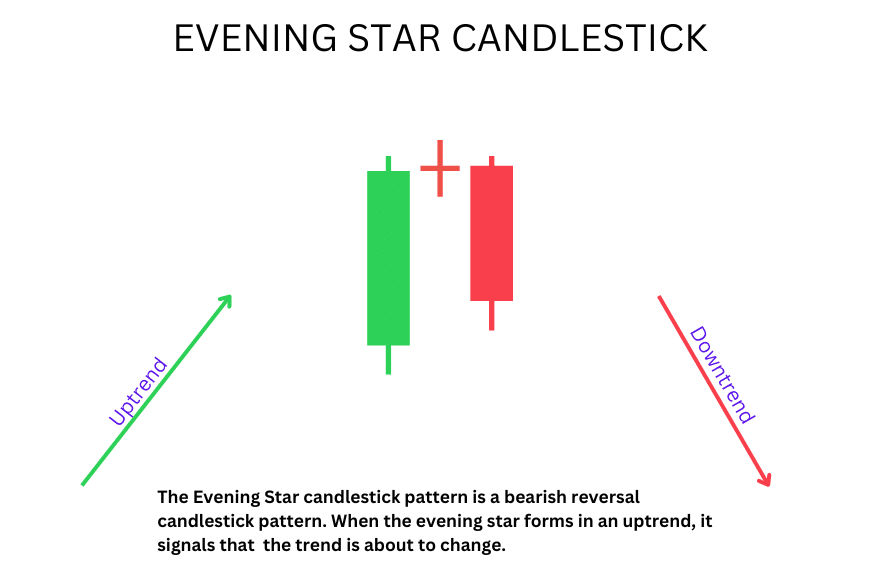
As Evening Star is a bearish pattern, its opposite is the Morning Star Candlestick Pattern, a bullish candlestick pattern that reverses the downtrend to the uptrend.
How Evening Star Candlestick Works?
Understanding the functionality of the Evening Star candle is relatively easy.
Let’s make it simple by understanding basic things: A candlestick shows the changes in price with four points, which are open, close, high, and low.
The price movement between opening and closing is the candle’s body, and high and low are shown with wicks.
The bigger the candle, the bigger the price movement in the stock chart; the less the move, the less the price movement.
Now, in the Evening Star pattern, there are three candlesticks right. So, let’s understand the process/psychology behind each of the three candles:
- The first big green candle shows that the stock price is increasing, and buyers are pushing the price up, which shows the continuation of an uptrend in short.
- The second candle is a small doji candle, where the price stops going up and not even going down. This candle shows there is confusion between buyers and sellers, and price cannot decide who is strong cause both are equal in power.
- The third candle, the last candle in this pattern, completes the evening star. This candle shows buyers are not strong now, and sellers are stepping in. So the prices which have increased so far will start falling now.
Example of Evening Star Candlestick Pattern
Example 1
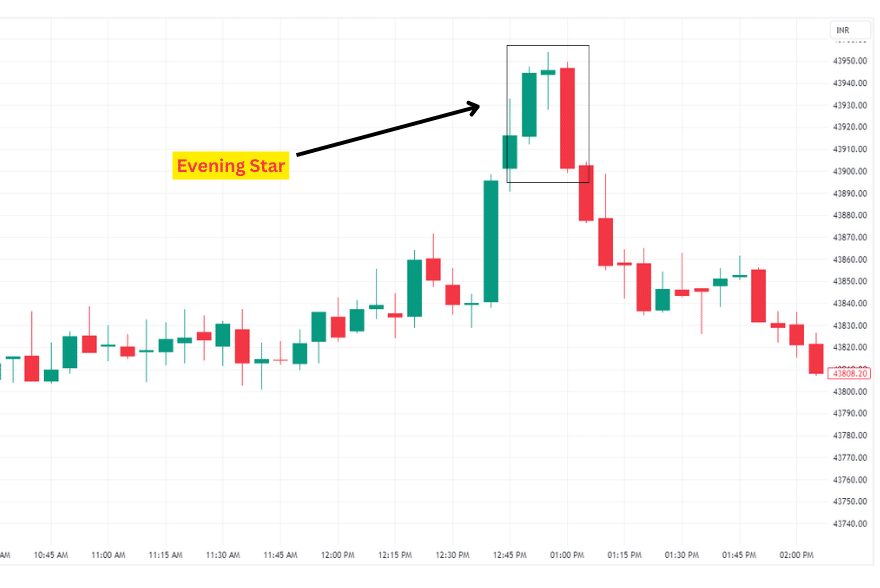
As we can see in the above image, It’s the BANKNIFTY 5m Time Frame chart, in which we can see that the price was moving in an uptrend.
The first candle in the evening star is a big green candle, indicating bulls are controlling the price and pulling it up.
Then, in the second doji candle, we can see that bulls try again, but this time, they are not able to pull the price up successfully as bears enter and try to pull the price down, but they also fail, and the price stated at the same open-close level.
In the third candle, we can see bulls are entirely lost, and bears stepped in and started to pull the price down, and then the price began to fall.
Example 2
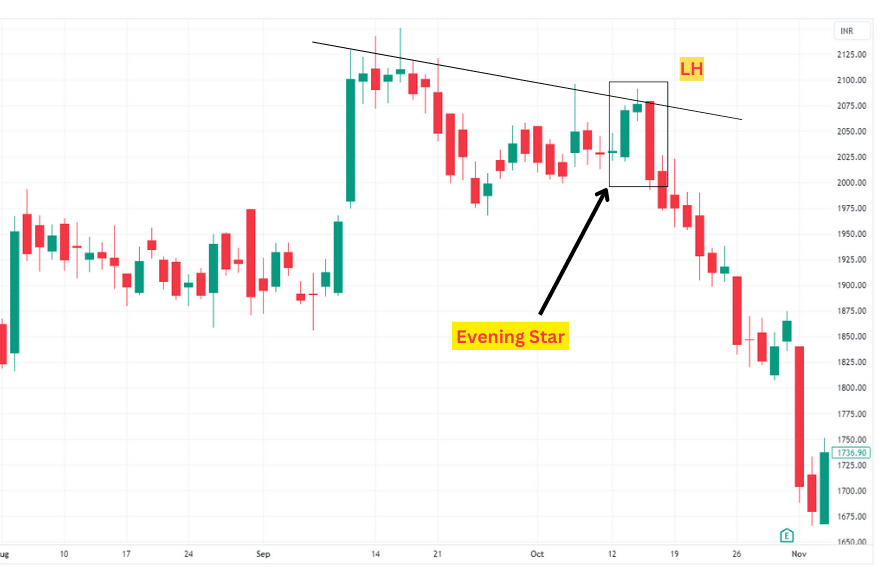
As we can see in the second example, it’s a RELIANCE 1D Time Frame chart, in which the price was going with higher-high and Higher-low patterns, which means an uptrend.
Then suddenly, the Lower-High forms, and at Lower-High, we can see a proper Evening Star candlestick pattern, and then the price starts to fall as expected.
Things to Keep in Mind While Trading Evening Star Candle
The Evening Star candle pattern is reliable while trading, and it has a high win ratio compared to other candlestick patterns.
But it doesn’t mean it won’t fail like other patterns. It also fails sometimes, and that’s why we should always use proper stop loss and risk management while trading.
We should always use evening star candles with other factors on the chart, such as price action, support-resistance, trend, etc., which are also involved in one successful trade.
This is a bearish reversal pattern, so we should always consider this pattern in uptrend or lower high levels.
There are more bearish reversal patterns that I use most, such as Shooting Star, Hanging Man, Dark Cloud Cover, Bearish Engulfing, Marubozu, etc.
Conclusion
The Evening Star candlestick pattern is a powerful bearish reversal pattern that traders can use to identify a potential trend change at the top of an uptrend.
This pattern can help you make informed decisions and capture profitable trades correctly.
But in the end, it’s trading we are talking about, so either you can make a profit or a loss, and as it involves loss, we should always consider proper money management and risk management while trading.
With practice and experience, you can use candlestick patterns like the Evening Star to improve your trading skills and achieve consistent profits.
Frequently Asked Questions (FAQ)
How accurate is the evening star candlestick?
Some experts say the evening star candlestick pattern is about 70% to 75% accurate. This means if you trade with only evening star candlestick, then out of 10 trades, you will always win 7 trades, sometimes 8.
What is the 3rd-day candle in the evening star candlestick pattern?
The 3rd-day candle is a bearish candle, which indicates rising selling pressure in the price and trend reversal.
Which is best candlestick pattern?
The most popular and reliable pattern is the bullish or bearish engulfing pattern.
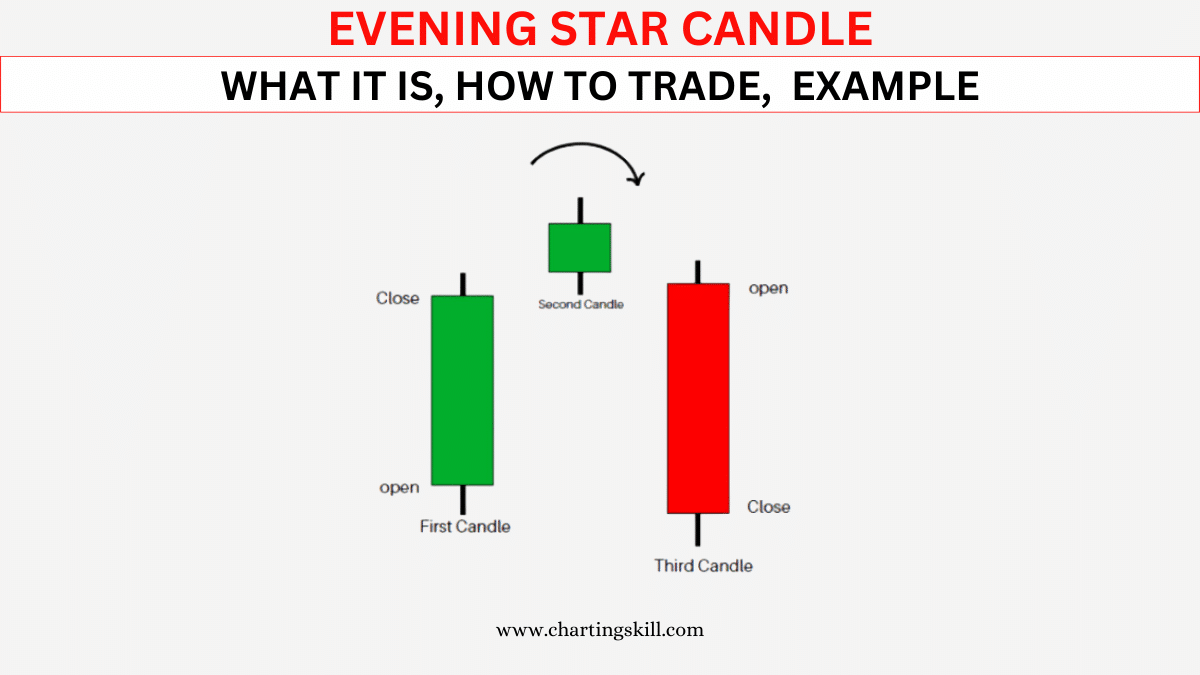


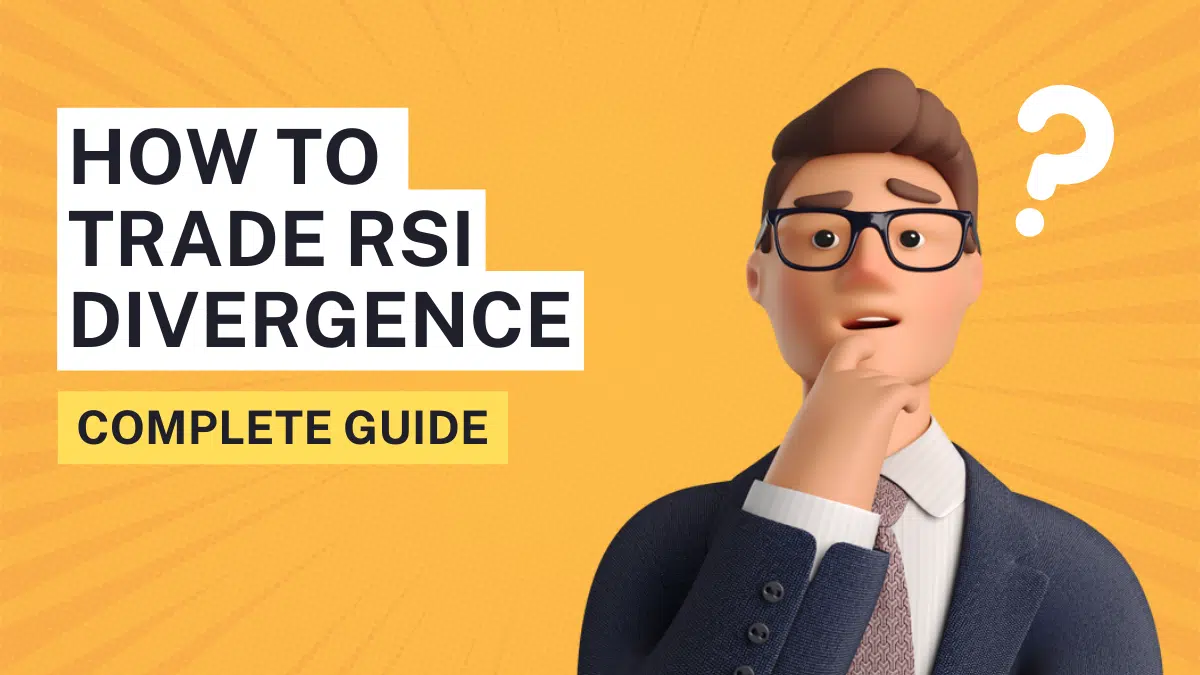



Simple and very easily explained.
Thank you for reading!!
Stay connected for more awesome content!